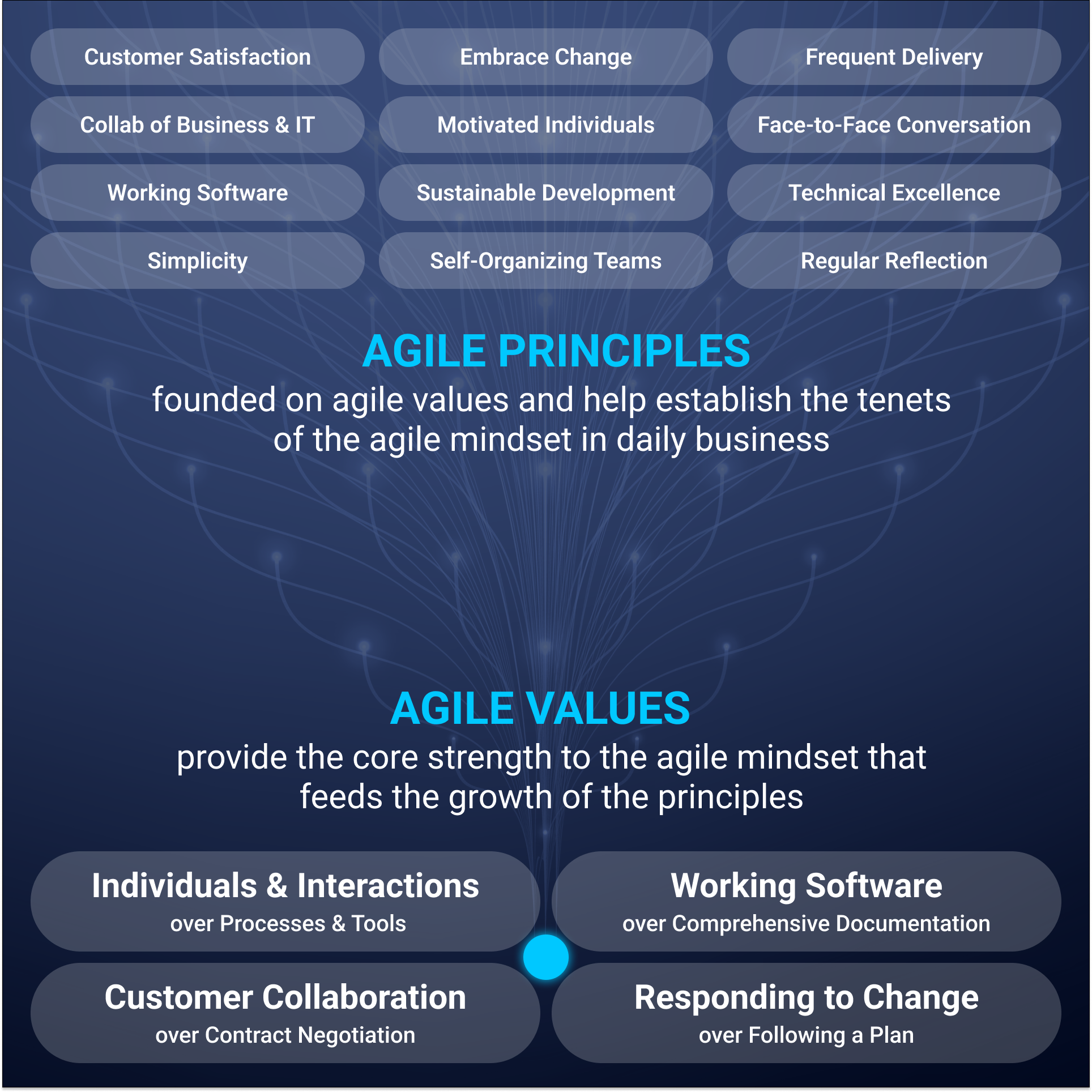In our last blog we discussed reasons for agile immaturity, one of which was the lack of an agile mindset. As this key element of successful agile transformations presents a stumbling block for many organizations, we would like to delve deeper into the topic. In the following article we share a definition, talk about the importance and characteristics of an agile mindset, and provide recommendations on how to build-up a lasting attitude.
Agile Boost Required?!
When managers from different companies approach us to get advice, we often receive statements within the same realm. Either they wonder why their employees lose commitment to agile tools, methods, and practices, or they tell us that they had hoped for more benefits from the agile way of working. In most cases, however, it quickly becomes clear that the focus in these organizations is merely on “doing agile” and less on “being agile”.
With “doing agile”, we are talking about the regular application of agile practices like stand-ups, retrospectives, refinement meetings or iterations. No doubt, solely by applying these practices correctly you can already create benefits like improved product quality, increased productivity, or shorter release cycles. However, to reap additional benefits and to really experience a boost in the organization, you need to increase your focus to “being agile”. It is a cultural change, and the first step is the right agile mindset, which is often missing to unleash the full potential of agile, and to create a dynamic organization full of vigor.
Characteristics of an Agile Mindset
But what is an agile mindset? In short, an agile mindset combines certain beliefs, attitudes, and actions of agile leaders and practitioners. It is defined by four values, described by the twelve principles of the Manifesto for Agile Software Development (“being”) and then manifested through an unlimited number of practices and different ways of working (“doing”). To elaborate a little more – the agile values provide the core trunk and solidity to the agile mindset and give context that feeds the growth of the principles, frameworks, and practices, whereas agile principles help establish the tenets of the agile mindset.
Especially in times where customer requirements are in constant motion, internalizing these values and principles helps product/service teams to become more adaptable, collaborate more effectively, use feedback to modify previous ways of working and ultimately to achieve high-performing results. It also acknowledges the need for learning, experimentation, and continuous improvement to meet challenging customer demands. Ultimately, it establishes a “growth mindset”, rather than a “fixed mindset”.
Build an Agile Mindset
The discussion about changing a mindset is about replacing familiar thought patterns, behaviors, and structures with new ones. This is a difficult endeavor as you cannot just change one´s working habits and culture overnight. However, based on our experience from multiple agile transformations, there are five focuses that we share from our projects for you to consider and as suggestions of where to start:
1. Jointly build and share a common vision
Truly agile organizations focus on their relationships with customers and employees. Their wishes and expectations count and are considered in agile planning of daily work. Moderate the mindset shift from market demands, annual goals, and deadlines, to creating a culture of servant leadership throughout the company. That means creating an attitude of team leaders and product owners oriented towards the needs and interests of internal and external customers. Start by defining a joint vision together which places them at the center of all activities. Ensure the common vision is understood and lived throughout the organization, and build an employees’ sense of belonging and purpose.
2. Learn to inspect & adapt
The core of agile is about being responsive to change, to adapt workflows or final product based on changing user and team needs. Establish this by creating an environment with feedback loops, team reflections, flexible plans, the space for innovation and experimentation, for training and self-study. Make sure you do not judge team members when things go wrong, but rather encourage them to learn from their mistakes and to get it right next time. This causes the mindset to shift as there is the space to test, adapt and succeed in daily work.
3. Build-up team spirit
Agile relies on people working together fluidly, which is achieved through transparent collaboration, requiring high levels of team spirit. Build it, through face-to-face team activities, team games or even team assessments to explore behavioral style, personal motivators, acumen, and competencies. Knowing each other personally will increase trust and respect between team members. Also improve communication by scheduling temperature checks, encouraging team members to share and discuss obstacles, and collaborate on solutions.
4. Ensure openness through communication
Communication is the basis for making processes and developments work. Ensure that the required communication and support channels are established early-on and known to everyone to support efficient communication and collaboration right from the beginning. Actively seek dialogue, find individual pain points, and take time to explain the idea behind agile ways of working. Provide the most important theoretical content, lessons learned and latest trends also in written form. Soon, they will build-up a sense of purpose, increase their confidence and motivation to try the new way of working, and discover the benefits of working agilely.
5. Streamline your work- and communication flows
An agile mindset depends on simple workflows and easy collaboration so that time is used productively. Do this by providing and using technological tools that facilitate communication, task management and project planning. In parallel, try to reduce approval workflows, complex documentation, and hierarchical decision-making to empower self-organized teams. Your team will thank you.
Concluding Remarks
If your organization is only “doing agile”, but not “being agile”, it is time for you to change it step by step towards the latter. Implementing an agile mindset is paramount, as this is built on certain values and principles that support to build a fruitful culture of flexibility, collaboration, trust, and simplicity in everyday workflows. It helps to reinforce the use of agile methods and tools as your employees are truly ready and intrinsically motived. But do not get us wrong – we are not arguing that agile methods and associated practices are not important for your agile transformation. However, we firmly believe that organizations must place a much greater focus on the establishment of the agile mindset to increase the probability of a successful transformation and return on investment.
A comprehensive assessment, accompanied by end-to-end trainings and best practice communication concepts can moderate the cultural change within your organization.
This blog is part of a series on Agile Organizational Design. Click here to see part 1.


